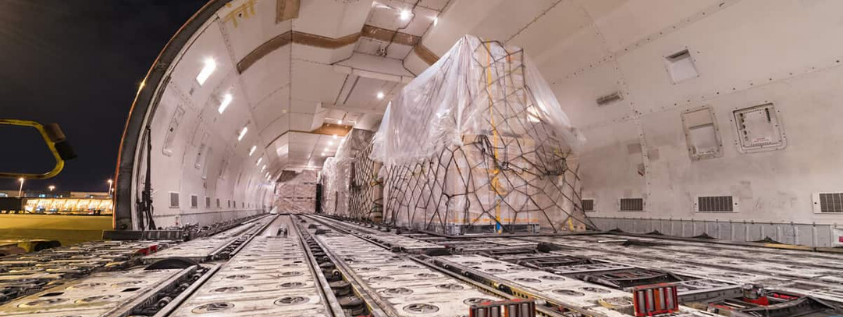Air freight is used in almost all industrial sectors and distribution chains. The use of the airplane as a means of transport is ideal for certain goods, such as high value finished products, urgent goods, etc., but is not advisable for others such as bulk, low value and high weight and/or volume goods, for technical or cost reasons.
Some of the advantages offered by the air transport of goods are its punctuality and speed, since only the airplane offers the possibility of transporting goods to any place in the world within 24 hours. In some regions of Africa, South America, Asia or Oceania, the plane is also the only means of access. Moreover, its safety – in 2019 there were only 6 accidents on cargo flights worldwide – makes it the most reliable means of transport.
There are several models of aircraft used in the transport of goods. From small aircraft, such as the Cessna Caravan, to the giant Antonov An225 – the largest cargo plane ever built – which can carry 250 tons almost 8,000 kilometers away. In addition to these “pure” freighters, on each commercial passenger flight a greater or lesser percentage of the holds are occupied by “pallets” of cargo, which are added to the passengers’ luggage.
An important driving force for air cargo in recent years has been the increasing use of the Internet and e-commerce, as products purchased through online orders are often at the opposite end of the world, and need to be transported as quickly as possible, something that the other type of transport cannot offer.
Air transport of goods in Spain
Due to the growth of e-commerce and urgent cargo shipping, air freight has been growing exponentially in Spain over the last few years. Aena’s airport network has recorded a volume of goods of 499,561 tons in the first half of 2019, which represents a 3.7% increase over the same period last year. Since 2013, air cargo in Aena’s network has experienced continuous year-on-year growth.
The main air cargo centres in Spain are Madrid-Barajas, Barcelona-El Prat, Zaragoza and Vitoria airports.
If in Barcelona -which has a refrigeration unit- the main element is the product of the pharmaceutical industry -which, although of low relevance in terms of weight, has a high added value- Zaragoza airport has experienced a strong increase in tons transported thanks to the products of the textile sector. From having a market share of 1.44% in 2004, the Aragonese airport has gone from 16.5% in 2018, which implies a growth of 17.3%. The cause of this growth is due to the presence of the company Inditex, which locates the logistics platform of its commercial brand Zara from where the women’s collection is distributed worldwide in this airport. Of the 350 million garments that the brand distributes each year, 40% are transported by air, which explains why Inditex is behind 97% of the goods traffic at Zaragoza airport.
In contrast, the airports in Spain where air transport has suffered a decrease are those of the Canary Islands, Alicante, Valencia or Mallorca, where the development of roads or maritime links has made airplanes less competitive on short routes and used to transport air freight on longer journeys.
To see the evolution of international air cargo transport at Spanish airports (kilograms) by geographical area of origin/destination and type of operation, consult the following link.
Main companies
The companies that transport most air freight to and from Spain are DLH and Iberia. The type of goods usually transported by DHL are textiles, sports goods, technology, pharmaceutical products, car parts, etc. Iberia, in its case, is the air cargo carrier that markets its parent company IAG, which also integrates British Airways, Vueling and Aer Lingus. IAG exports more than it imports into Spain, especially food products.
Norwegian Air Shuttle has also been transporting air cargo in Spain since 2005. Its goods include car components, medicines and even foodstuffs such as guacamole sauce.
The Lufthansa Group, which includes Swiss, Austrian, Brussels Airlines and Eurowings, has Inditex, Airbus, Grifols, Novartis, VW, Nissan and BASF as its customers. It often transports products in its passenger planes, but mainly offers service through its subsidiary Lufthansa Cargo and a fleet of 6 MD11 planes – the last ones in service of this model of passengers transformed for cargo – and 7 Boeing B777 Freighter. Its main international hubs in Europe are Frankfurt, Munich, Düsseldorf, Brussels and Vienna.
However, we must not forget the great American giants of air transport such as DHL or FedEx, or other smaller but undoubtedly important companies such as Seur, Flightline or Swiftair.
Actually
The global crisis caused by the Coronavirus pandemic has highlighted the importance of air freight. During the worst moments of the health crisis, this type of transport has been fundamental for the urgent transport of medical material from production centres to their destinations, reaching growth of up to 30% globally during the first half of 2020.
Although air transport will have to adapt to the conditions of the post-Covid era. Forecasts state that the airline industry will be among the first to rebound when economic conditions improve. The decisive commitment of world governments in general, and of the European Union in particular, with important economic items aimed at cleaning up the economy of airlines and air cargo companies, augurs well for this.
